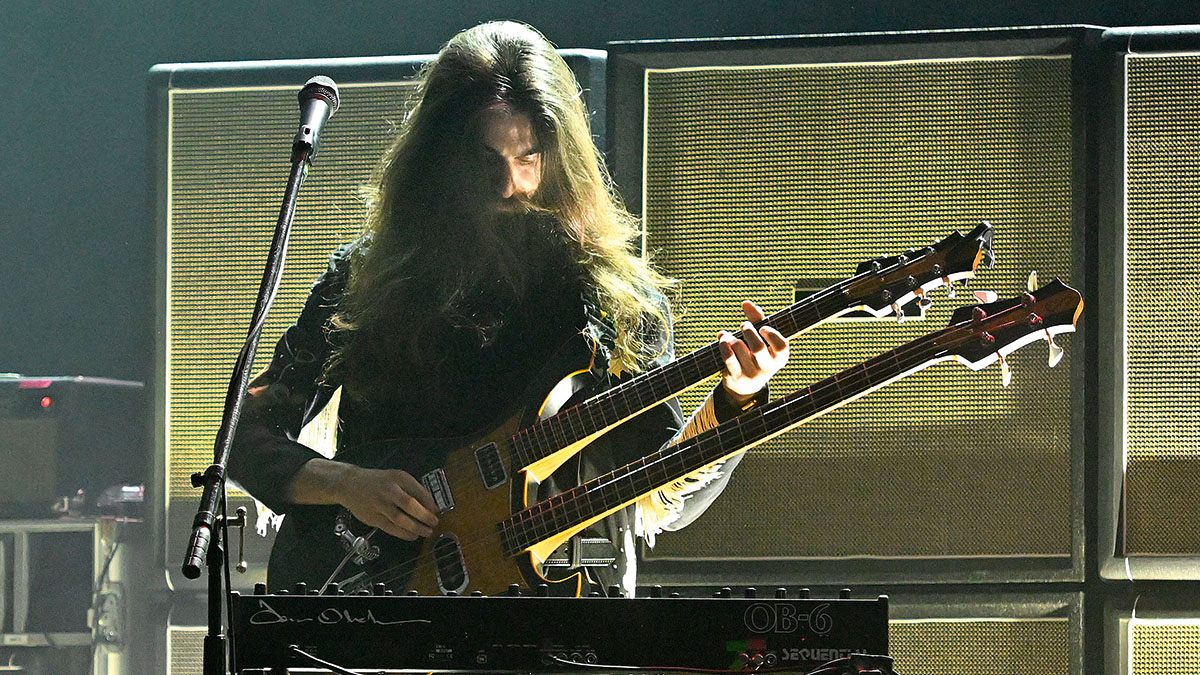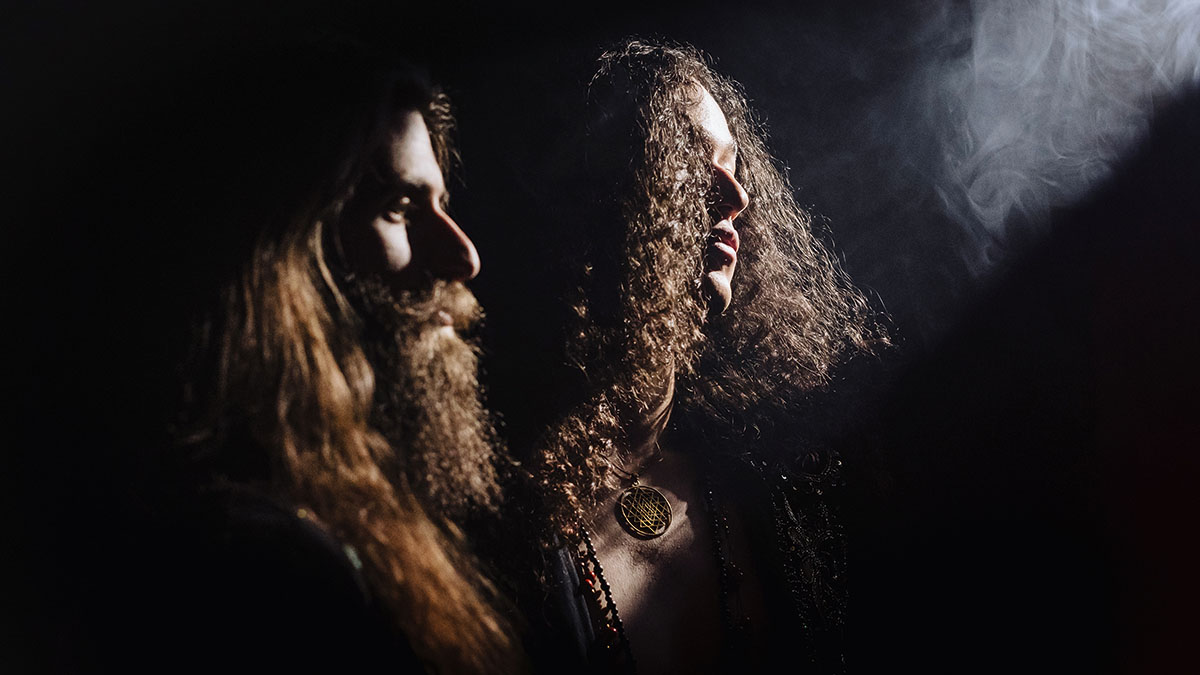Crown Lands’ doubleneck devotee Kevin Comeau on his fearless guitar/bass multitasking, recording with Alex Lifeson’s acoustic and why Smashing Pumpkins’ Siamese Dream is a tonal benchmark
Comeau unpacks his multi-instrumentalist approach on the Rush disciples’ impossibly expansive sound, and explains just exactly where he got that super-cool doubleneck

The past two decades have witnessed the rise of some impossibly thunderous two-piece bands, from the lo-fi vintage crackle of The White Stripes and The Black Keys to the modern-voiced heaviness of Death From Above 1979 and Royal Blood – all of whom have somehow been able to defy the laws of physics in terms of sheer dimension and spread.
You can now add Canadian duo Crown Lands to that list, given how singer/drummer Cody Bowles’ melodies and rhythms are elevated far into the cosmic beyond by multi-instrumentalist Kevin Comeau, who – much like a mad professor – beavers away behind a fortress of equipment in order to bring their sci-fi prog orchestrations to life.
Instead of signal splitting as per bands of the past, he switches between Rickenbacker guitar/bass double necks, vintage Gibson SGs, inexpensive Strats, 12-string acoustics, Moog Taurus pedals and synths to create a world of sound that truly needs to be seen in order to be believed.
“When we started out, I was really influenced by all those two-piece bands,” Kevin says, speaking from his home in Oshawa, Ontario. “I was doing that dual mono setup where you split your signal, sending your dry to one amp and an octave down to another.
“But I found it was muddying up what I was doing with the Taurus pedals. A lot of those other bands tend to play just one part and split. My bass pedals have their own lines. I do a lot of counterpoint. If I’m staying static on my guitar, I’ll play the melody on my Taurus and vice versa. I prefer to let my guitar play a traditional role – it gives me more low-end space for bass pedals.”
Being a progressive rock band from Canada, Crown Lands are following in the footsteps of legendary trio Rush. And for Kevin, having initially fallen in love with punk rock during his early teens, it was the song Xanadu – the 11-minute epic from Rush’s 1977 album A Farewell To Kings – that inspired his own grandiose and elaborate musical experimentations.
He says he owes “everything to listening to Rush at the right time in life”, which led to him going back to discover “the older, weirder side of prog like Yes, King Crimson, Genesis, Van Der Graaf Generator and Tangerine Dream instead of Dream Theater and more modern stuff.”
Get The Pick Newsletter
All the latest guitar news, interviews, lessons, reviews, deals and more, direct to your inbox!
The opening track on Crown Lands’ new album Fearless is an 18-minute epic titled Starlifter: Fearless Pt. II. As far as opening gambits go, this one takes the listener right into the deep end. “Most of that was written over a couple of weeks,” Kevin says, “except for the end part which was going to be its own 15-minute song about black holes. We found a Ted Talk by Stephen Hawking, so we sampled him into this instrumental ’90s Floyd-esque piece which ended up going nowhere, except for that one section we moved over.”
If this all sounds like the kind of thing Rush would do, well, that’s because it is. When Kevin talks about the first part of Starlifter – what he calls “the opening overture”, which he says “represents a fight between good and evil” – he likens it to another classic Rush song from the ’70s, By-Tor And The Snow Dog.
He also acknowledges the influence of Rush in how he mainly works in DADGAD and open C tunings to help emulate keyboard voicings. “I like using texture and timbre to tell a story as effectively as lyrics. It’s all very hopeful with the big suspended chords and then we do this chromatic shift into B flat, which suddenly makes you feel like we’re in D minor.
“We live in a Mixolydian world of always having that flat seven, and that’s the sound of Rush, to the point where I’d say 90 per cent of Rush’s music is in E Mixolydian. Xanadu is a perfect example, though the chorus is probably more like D Mixolydian. While a lot of classical musicians would frown upon that, we love those subtle modulations. Starlifter mainly sits in this modal D area which shifts between major and minor. Yeah, it’s a bit of a gauntlet to play through it all!”
If you’ve seen any footage of Crown Lands live, you’ll most likely have already marvelled at the sheer magnitude of Kevin’s rig. He agrees that his somewhat unconventional role does present its fair share of challenges, especially given he has to pay great consideration to the physical limitations of having only one pair of hands and feet for live performances.
He also admits his decision to track guitar and bass separately for parts of the new album became “a big point of contention” for the duo, though stands by his decision. “We’d arranged previous recordings on my doubleneck,” he explains. “This time I said ‘Fuck it! I’m tracking bass and guitar separately.’
“I wanted the music to sound timeless... It will live longer than we will. I wanted to make sure the recorded version sounded more like how I heard it in my head. Cody was like, ‘How are you going to pull that off live?’ I’ve arranged the live versions thinking, ‘Who is the hero here, the guitar or the bass?’ – and that’s how I’ll switch between the two on stage.”
All of the rhythms on the album were recorded with Kevin’s two Gibson SGs – a 1969 transition model with ’68 pots and a more recent SG Classic fitted with P-90s, although he doesn’t tour with them for fear of neck breakage.
“I love those late-’60s Gibsons,” he says. “I find the necks are so interesting. You have the skinny nut and the neck is slim but by the seventh fret it becomes a baseball ball C-shape and fills your hand so nicely. The T-Top pickups in that ’68/’69 SG has this clarity and sparkle you don’t get from any other humbucker.”
He describes the tone as “slightly scooped”, especially when compared to the Classic, which carries more mid-range grunt and sustain. Those guitars were doubled and panned hard left and right, with his Rickenbacker 12-string tracked dead centre to help thicken out various parts.
“I love that kind of sound,” he continues. “Siamese Dream by The Smashing Pumpkins is a huge benchmark for me in terms of guitar tone. I love how Billy Corgan layered dirty guitars with clean guitars to create a guitar orchestra.”

Then there’s the black Mexican Strat he used for a lot of the leads, which he “bought for $200, retuned to CGCGCE and never looked back”. Unlike Alnico single-coils, he explains, the ceramics in that guitar have a darker thump that sits closer to humbuckers.
Its white pickguard was eventually swapped out for a black one in tribute to David Gilmour (“it had to be done!” he grins). Another instrument of note is the vintage K. Yairi-made Alvarez acoustic heard on Penny.
“The brass nut and bridge buzzes in a certain way while the mahogany back and sides make it sound very dark and folky,” he says. And then, of course, there’s the Alvarez doubleneck given to the band by none other than Rush guitarist Alex Lifeson...
“We did a charity gig with Alex a few years ago, he was the nicest guy,” Kevin recalls. “We played Led Zeppelin’s The Battle Of Evermore and then went into Stairway To Heaven. Alex lent me his white Gibson EDS-1275 to do the 12-string part while he ripped the solo. I had the guitar for a bit then he asked for it back when he did that charity auction. He felt bad, so ended up giving me this old Alvarez double-neck he wasn’t playing much. I used it for most of the acoustic parts on the record.”
The rest of Kevin’s tone comes from combining Hiwatt with Fender amps, a blend which the guitarist attests to being “the main secret of my sound”. There’s something magical that happens when you marry the mid-presence from the EL34s in a British-style amp with the scooped punch you get from American-voiced 6L6s, he says – demystifying how one person alone can cover so much ground in a power duo.
“I ended up getting a deal with Hiwatt because all my favourite guitarists sounded their best when they used those amps. It’s that hi-fi sound which shows every mistake, making you a better player in the long run! Alex Lifeson used them from Hemispheres in 1978 through to Moving Pictures in 1981, my favourite era of his tone.
“Pete Townshend had them for The Who’s Live At Leeds. Another favourite is Adam Granduciel from The War On Drugs – their Live Drugs record is the pinnacle of tone. It captures the raw ferocity of Neil Young with the phrasing and magic of David Gilmour, who typically used single-coil guitars through a shit ton of clean boosts, a couple of Hiwatts and a Leslie.”

Speaking of pedals, there’s no shortage of shimmering modulations heard on the latest recordings, mainly courtesy of the Boss CE-1 chorus that Kevin describes as his “favourite stompbox ever”, thanks to its triangle wave LFO instead of the sine wave usually found on other units.
There’s an unevenness to it, he explains, that adds even greater dimension to the layers of noise. “I used my Eventide TimeFactor and MXR Micro Flanger a lot, too,” he adds. “I also love my Diamond Compressor when using single coils. I don’t squish too much, but I like the extra push. And I love my Xotic EP Booster, it’s a classic for a reason. Everyone says when you get that pedal, you’ll never turn it off and that’s so true... it’s the ultimate ‘always-on’!”
- Fearless is out now via Spinefarm.
Amit has been writing for titles like Total Guitar, MusicRadar and Guitar World for over a decade and counts Richie Kotzen, Guthrie Govan and Jeff Beck among his primary influences as a guitar player. He's worked for magazines like Kerrang!, Metal Hammer, Classic Rock, Prog, Record Collector, Planet Rock, Rhythm and Bass Player, as well as newspapers like Metro and The Independent, interviewing everyone from Ozzy Osbourne and Lemmy to Slash and Jimmy Page, and once even traded solos with a member of Slayer on a track released internationally. As a session guitarist, he's played alongside members of Judas Priest and Uriah Heep in London ensemble Metalworks, as well as handled lead guitars for legends like Glen Matlock (Sex Pistols, The Faces) and Stu Hamm (Steve Vai, Joe Satriani, G3).
Ozzy Osbourne’s solo band has long been a proving ground for metal’s most outstanding players. From Randy Rhoads to Zakk Wylde, via Brad Gillis and Gus G, here are all the players – and nearly players – in the Osbourne saga
“I could be blazing on Instagram, and there'll still be comments like, ‘You'll never be Richie’”: The recent Bon Jovi documentary helped guitarist Phil X win over even more of the band's fans – but he still deals with some naysayers










